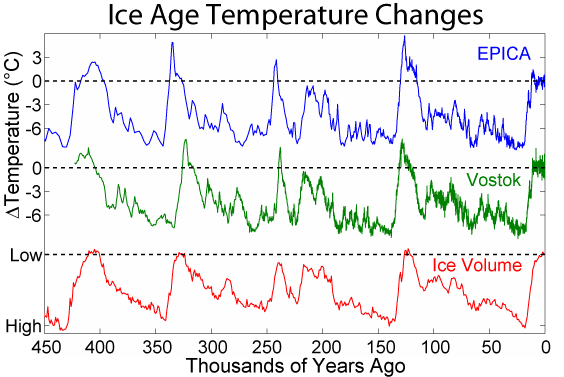2017年10月06日
The latest! Full view of the Milky Way
(最新 見えた!銀河系の全貌)
The latest! Full view of the Milky Way (最新 見えた!銀河系の全貌)
https://youtu.be/4z4deL4Neq0
The latest! Full view of the Milky Way
(最新 見えた!銀河系の全貌)
https://youtu.be/4z4deL4Neq0
Published on Jan 24, 2017
あなたも見ることができます: 最新版 宇宙の巨大天体 最新版 宇宙ナビ 宇宙旅行 .
あなたも見ることができます: 驚異の大宇宙〜 見えた!銀河系の全貌 量子の制御とコンピュータ .
5.5億年前のカンブリア爆発以降の5回の地球上の生物種の大量絶滅、8300万年前の恐竜の衰退、地球の温暖化・寒冷化の長周期変動、大気中のCO2.
Category Education
License Standard YouTube License
☆===================================================☆
☆ Reference Link ☆
1. 地球は寒冷期に突入!!
http://waav.xsrv.jp/solacolor/?page_id=2677
地球に降注ぐ宇宙線の変化
われわれの天の川銀河は最新の観測結果で棒渦巻き型銀河と判明した。写真の様に中心部の細長い楕円と4本のスパイラル・アームでできている。その中を太陽系は毎秒240kmで銀河を回っている。銀河を一周するのには約2億年かかる。太陽系の位置は(図を参照)現在スパイラル・アームとスパイラル・アームの中間に位置している。スパイラル・アームとは、雲の様に渦巻き状の帯で、ここでは星の密度が高く超新星爆発が多発している。超新星爆発の爆発の際、大量の宇宙線が放出される。宇宙線とは、高エネルギーの放射線のことで、主な成分は陽子(全体の約86%程度)であり、アルファ粒子、リチウム、ベリリウム、ホウ素、鉄などの原子核が含まれている。観測の結果、スパイラル・アームへの太陽系の周期も1億4000万年であることが判明した。つまり、グラフの様に宇宙線量と温度変化が両方とも1億4000万年周期で一致することが判明した。
宇宙線が地球の寒冷化を引き起こす?
空気中の水蒸気に宇宙線がぶつかると雲が発生し、特に上空3キロ程度までの雲は太陽光を大きく反射し地球を寒冷化させます。宇宙線が多いほど雲の発生が多くなり地球は寒冷化し、少ないと地球は温暖化します。この現象は、目に見えない放射線を観測するための実験装置、「霧箱」で実証されました。水蒸気に宇宙線がぶつかると雲が発生する様子が解ります。だが、高エネルギーの宇宙線から、地球は太陽風と地球の磁場によって守られている。太陽風は、太陽から吹き出す極めて高温で電離した粒子(プラズマ)のことで、太陽風には太陽内の水素・ヘリウムおよびそれらの同位体が含まれており、月などの大気のない天体表面にはそれらが堆積している。 特に未来の技術、核融合の燃料として有望なヘリウム3が月には豊富に堆積している。宇宙線は電荷を持っているので、地球にたどり着くまでに太陽風の磁場と地球の磁場の影響で減少する事が知られていますが、現在太陽では、これまで11年周期で増減を繰り返してきた黒点が、減った まま増えない大きな異変が起きています。国立天文台などの国際研究チームによると、太陽観測衛星「ひので」は太陽の磁場の反転を世界で初めて確認した。通常、太陽の磁場は南極と北極が同時に反転するが、北極がマイナスからプラスになっているのに南極がプラスのまま変わらない状況が確認された。この現象は約170年前と約370年前に起きたとみられており、それぞれの約10年後には太陽の黒点の数が減って地球が寒冷化したとされています。太陽活動が低下し、(黒点の減少は太陽の活動エネルギーとは関係なく地球に届く光の量は過去から一定です。)黒点が消えると、太陽を取り巻く磁場が小さくなるり、宇宙から降り注ぐ宇宙線に働く太陽の磁場の影響が小さくなり,地球に降り注ぐ放射線が増えることになり、雲の量が増えて地球は寒冷化することになります。二酸化炭素による地球温暖化だけがクローズアップされてきましたが、単なる自然のゆらぎのひとつだったと言うことになるかもしれません。気になる事は、太陽黒点が少ない活動極小期に巨大地震の発生頻度が上昇することが,九州大学宙空環境研究センターの分析結果によって指摘されています。M8.0以上の巨大地震に至っては全28回のうち79%が最小期に発生していました。この近未来の予測が当たったとすると温暖化より怖い寒冷化は、食料不足と燃料不足を招き大変な事にないそうな気配です。できれば、当たらない事を祈ります。
2. 銀河系
https://ja.wikipedia.org/wiki/%E9%8A%80%E6%B2%B3%E7%B3%BB
NASA/JPL-Caltech/ESO/R. Hurt - http://www.eso.org/public/images/eso1339e/
This detailed annotated artist’s impression shows the structure of the Milky Way, including the location of the spiral arms and other components such as the bulge. This version of the image has been updated to include the most recent mapping of the shape of the central bulge deduced from survey data from ESO’s VISTA telescope at the Paranal Observatory.
3. " Ice age " :Wikipedia
https://en.wikipedia.org/wiki/Ice_age
https://en.wikipedia.org/wiki/Ice_age#/media/File:Ice_Age_Temperature.png

Shows the pattern of temperature and ice volume changes associated with recent glacials and interglacials
Glacials and interglacials
Within the ice ages (or at least within the current one), more temperate and more severe periods occur. The colder periods are called glacial periods, the warmer periods interglacials, such as the Eemian Stage.
Glacials are characterized by cooler and drier climates over most of the earth and large land and sea ice masses extending outward from the poles. Mountain glaciers in otherwise unglaciated areas extend to lower elevations due to a lower snow line. Sea levels drop due to the removal of large volumes of water above sea level in the icecaps. There is evidence that ocean circulation patterns are disrupted by glaciations. Since the earth has significant continental glaciation in the Arctic and Antarctic, we are currently in a glacial minimum of a glaciation. Such a period between glacial maxima is known as an interglacial. The glacials and interglacials also coincided with changes in Earth's orbit called Milankovitch cycles.
The earth has been in an interglacial period known as the Holocene for around 11,700 years,[36] and an article in Nature in 2004 argues that it might be most analogous to a previous interglacial that lasted 28,000 years.[37] Predicted changes in orbital forcing suggest that the next glacial period would begin at least 50,000 years from now, even in absence of human-made global warming[38] (see Milankovitch cycles). Moreover, anthropogenic forcing from increased greenhouse gases might outweigh orbital forcing for as long as intensive use of fossil fuels continues.[39]
Galactic spiral arm
宇宙線
☆===================================================☆
☆===================================================☆
☆===================================================☆
広告


☆===================================================☆
☆===================================================☆
☆===================================================☆
☆===================================================☆
https://youtu.be/4z4deL4Neq0
The latest! Full view of the Milky Way
(最新 見えた!銀河系の全貌)
https://youtu.be/4z4deL4Neq0
Published on Jan 24, 2017
あなたも見ることができます: 最新版 宇宙の巨大天体 最新版 宇宙ナビ 宇宙旅行 .
あなたも見ることができます: 驚異の大宇宙〜 見えた!銀河系の全貌 量子の制御とコンピュータ .
5.5億年前のカンブリア爆発以降の5回の地球上の生物種の大量絶滅、8300万年前の恐竜の衰退、地球の温暖化・寒冷化の長周期変動、大気中のCO2.
Category Education
License Standard YouTube License
☆===================================================☆
☆ Reference Link ☆
1. 地球は寒冷期に突入!!
http://waav.xsrv.jp/solacolor/?page_id=2677
地球に降注ぐ宇宙線の変化
われわれの天の川銀河は最新の観測結果で棒渦巻き型銀河と判明した。写真の様に中心部の細長い楕円と4本のスパイラル・アームでできている。その中を太陽系は毎秒240kmで銀河を回っている。銀河を一周するのには約2億年かかる。太陽系の位置は(図を参照)現在スパイラル・アームとスパイラル・アームの中間に位置している。スパイラル・アームとは、雲の様に渦巻き状の帯で、ここでは星の密度が高く超新星爆発が多発している。超新星爆発の爆発の際、大量の宇宙線が放出される。宇宙線とは、高エネルギーの放射線のことで、主な成分は陽子(全体の約86%程度)であり、アルファ粒子、リチウム、ベリリウム、ホウ素、鉄などの原子核が含まれている。観測の結果、スパイラル・アームへの太陽系の周期も1億4000万年であることが判明した。つまり、グラフの様に宇宙線量と温度変化が両方とも1億4000万年周期で一致することが判明した。
宇宙線が地球の寒冷化を引き起こす?
空気中の水蒸気に宇宙線がぶつかると雲が発生し、特に上空3キロ程度までの雲は太陽光を大きく反射し地球を寒冷化させます。宇宙線が多いほど雲の発生が多くなり地球は寒冷化し、少ないと地球は温暖化します。この現象は、目に見えない放射線を観測するための実験装置、「霧箱」で実証されました。水蒸気に宇宙線がぶつかると雲が発生する様子が解ります。だが、高エネルギーの宇宙線から、地球は太陽風と地球の磁場によって守られている。太陽風は、太陽から吹き出す極めて高温で電離した粒子(プラズマ)のことで、太陽風には太陽内の水素・ヘリウムおよびそれらの同位体が含まれており、月などの大気のない天体表面にはそれらが堆積している。 特に未来の技術、核融合の燃料として有望なヘリウム3が月には豊富に堆積している。宇宙線は電荷を持っているので、地球にたどり着くまでに太陽風の磁場と地球の磁場の影響で減少する事が知られていますが、現在太陽では、これまで11年周期で増減を繰り返してきた黒点が、減った まま増えない大きな異変が起きています。国立天文台などの国際研究チームによると、太陽観測衛星「ひので」は太陽の磁場の反転を世界で初めて確認した。通常、太陽の磁場は南極と北極が同時に反転するが、北極がマイナスからプラスになっているのに南極がプラスのまま変わらない状況が確認された。この現象は約170年前と約370年前に起きたとみられており、それぞれの約10年後には太陽の黒点の数が減って地球が寒冷化したとされています。太陽活動が低下し、(黒点の減少は太陽の活動エネルギーとは関係なく地球に届く光の量は過去から一定です。)黒点が消えると、太陽を取り巻く磁場が小さくなるり、宇宙から降り注ぐ宇宙線に働く太陽の磁場の影響が小さくなり,地球に降り注ぐ放射線が増えることになり、雲の量が増えて地球は寒冷化することになります。二酸化炭素による地球温暖化だけがクローズアップされてきましたが、単なる自然のゆらぎのひとつだったと言うことになるかもしれません。気になる事は、太陽黒点が少ない活動極小期に巨大地震の発生頻度が上昇することが,九州大学宙空環境研究センターの分析結果によって指摘されています。M8.0以上の巨大地震に至っては全28回のうち79%が最小期に発生していました。この近未来の予測が当たったとすると温暖化より怖い寒冷化は、食料不足と燃料不足を招き大変な事にないそうな気配です。できれば、当たらない事を祈ります。
2. 銀河系
https://ja.wikipedia.org/wiki/%E9%8A%80%E6%B2%B3%E7%B3%BB
NASA/JPL-Caltech/ESO/R. Hurt - http://www.eso.org/public/images/eso1339e/
This detailed annotated artist’s impression shows the structure of the Milky Way, including the location of the spiral arms and other components such as the bulge. This version of the image has been updated to include the most recent mapping of the shape of the central bulge deduced from survey data from ESO’s VISTA telescope at the Paranal Observatory.
3. " Ice age " :Wikipedia
https://en.wikipedia.org/wiki/Ice_age
https://en.wikipedia.org/wiki/Ice_age#/media/File:Ice_Age_Temperature.png

Shows the pattern of temperature and ice volume changes associated with recent glacials and interglacials
Glacials and interglacials
Within the ice ages (or at least within the current one), more temperate and more severe periods occur. The colder periods are called glacial periods, the warmer periods interglacials, such as the Eemian Stage.
Glacials are characterized by cooler and drier climates over most of the earth and large land and sea ice masses extending outward from the poles. Mountain glaciers in otherwise unglaciated areas extend to lower elevations due to a lower snow line. Sea levels drop due to the removal of large volumes of water above sea level in the icecaps. There is evidence that ocean circulation patterns are disrupted by glaciations. Since the earth has significant continental glaciation in the Arctic and Antarctic, we are currently in a glacial minimum of a glaciation. Such a period between glacial maxima is known as an interglacial. The glacials and interglacials also coincided with changes in Earth's orbit called Milankovitch cycles.
The earth has been in an interglacial period known as the Holocene for around 11,700 years,[36] and an article in Nature in 2004 argues that it might be most analogous to a previous interglacial that lasted 28,000 years.[37] Predicted changes in orbital forcing suggest that the next glacial period would begin at least 50,000 years from now, even in absence of human-made global warming[38] (see Milankovitch cycles). Moreover, anthropogenic forcing from increased greenhouse gases might outweigh orbital forcing for as long as intensive use of fossil fuels continues.[39]
Galactic spiral arm
宇宙線
☆===================================================☆
☆===================================================☆
☆===================================================☆
広告
☆===================================================☆
☆===================================================☆
☆===================================================☆
☆===================================================☆
【このカテゴリーの最新記事】
-
no image
この記事へのコメント
コメントを書く


